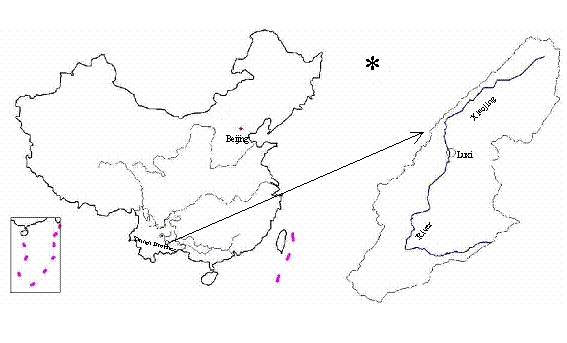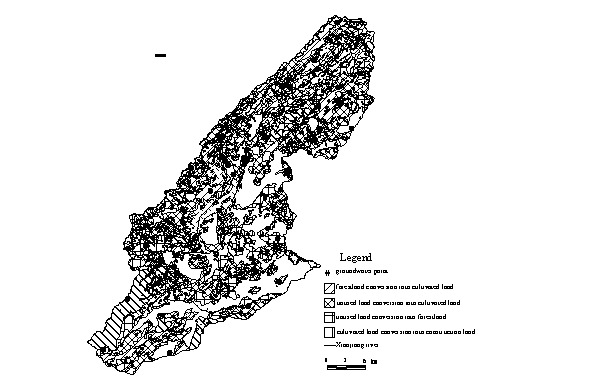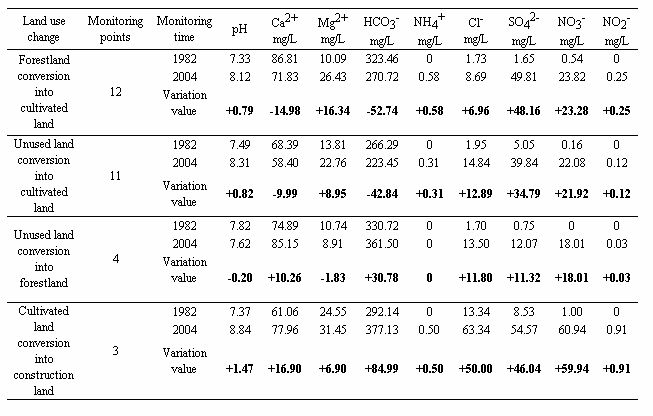Groundwater Quality Safety and Contamination Recovery
EFFECT OF LAND UTILIZATION CHANGE ON GROUNDWATER QUALITY --WITH THE XIAOJIANG RIVER DRAINAGE AREA AS AN EXAMPLE
Yong-jun Jiang1, Cheng Zhang1,3, Dao-xian Yuan1,3, Shi-you Xie1, Gui Zhang2, Rao-sheng He2
1 School of geographical Sciences, Southwest University, Chongqing 400715, China;
2 Institute of Geology Investigation in
3 Institute of Karst Geology, CAGS, Karst Dynamics Laboratory, M L R
Abstract: Supported by RS and GIS, land use change from 1982 to 2004 was analyzed, and the impact of land use change on groundwater quality of Xiaojiang watershed, a typical karst agricultural region of
Key words: Land use change; typical karst watershed; groundwater quality; Xiaojiang watershed;
Introduction
Karst has been regarded as a fragile environment by environmental scientists. Because of karst system with a low capacity, it is difficult to restore once disturbed (Yuan 1988,1993). Changes in hydrological balances are not unique to karst regions, but karst regions are more sensitive than others (LeGrand 1984). Because there is often little or no soil or cover which means poor filtration, poor pre-purification, rapid infiltration, and that flow is turbulent and conduit dominated, high flow velocities allow transit times that may be too short for microorganisms to die off, particularly in shallow groundwater systems. Because large numbers of interconnected fissures mean that pollution inputs are possible from the surface almost anywhere, karst groundwater’s particularly liable to contamination (Prohic 1989). Recent study has shown that land use change may give rise to a significant impact on karst groundwater quality. With forest clearance, the concentration of nitrate and chloride in the groundwater increase significantly (Kastrinos and White 1986; Mark 1998),and the expanding of cultivated land and developing intensive agriculture result in the increasing in the concentration of the nitrate, sulphate, phosphate and pesticides (Libra, et al. 1986,1987; Robert, et al, 1998; Molerio, et al 1998; Ramón et, al. 1998; Pertti et, al. 1999; Alice et, al. 1999; Andrzej 1999; Milde, et, al 1988; Zhang and Yuan 2004). Industrialisation and urbanization result in increasing concentrations of nitrate, sulphate, phosphate, and even causing bacteriological pollution (Howard 1989), organic contaminants (Barbee 1994; Fetter 1993; Barker 1996), and heavy metal contamination (André 1999; Jia and Yuan 2003).
In the present study we analyzed the land use change from 1982 to 2004, and assessed the effects of land use change on groundwater quality of the Xiaojiang watershed, a typical karst agricultural region of
The study area
The Xiaojiang watershed of Yunnan Province, Southwest China(Figure1), covers an area of about

Figure1 Location of the Xiaojiang watershed
Materials and Methods
Land use data and analysis
To facilitate the operation between series of spatial data, the land use category in Xiaojiang watershed is limited to 6 classes, i.e., forestland, cultivated land, unused land, orchard land, water bodies and construction land.
Land use data in 1982 (scale 1:50,000) was obtained from aerial photos from 1982 by interpreting, and verified and rectified through field survey.
Land use data in 2004 (scale 1:50,000) was obtained from Land-sat TM digital image in 2004 by supervised classifications, and checked by field survey.
The analysis of land use change was completed by Geographical Information System (GIS) software (ArcGIS and Professional MapInfo).
Water sampling and analysis
Thirty groundwaterwater points were monitored, of which 12 were cultivated land converted from forestland, and 11 were cultivated land converted from unused land, 4 forestland converted from cultivated land, and 3 construction land converted from cultivated land (Figure 2). Water samples were collected in the dry season (April) and rainy season (July) in 1982 and 2004, and measured in the field for pH, Ca2+, Mg2+, HCO3-by Multiline P3 pH/LF and Aquamerck, and subsequently analyzed in the laboratory for SO42-, NH4+, NO3-, NO2-, and Cl-.
Also, the climate data from 1980 to 2004 was collected in the Xiaojiang watershed.

Figure 2 Distribution of the monitored groundwater points
Results and Discussion
Land use change
Through spatial overlay analyzing two-period land use maps, which was supported by Geographical Information System, the land use change matrix was obtained (Table 1).
As shown in Table 1, land use changed significantly in the Xiaojiang watershed in the past 22 years. The percentages of land use for each type were 19.63 cultivated land, 27.84 forestland, 0.02 orchard land, 1.89 construction land, 0.72 water bodies and 49.9
unused land in 1982, respectively, but they were converted into 46.5, 27.47, 0.15, 3.24, 0.77 and
Table 1 The land use change matrix in Xiaojiang watershed from 1982 to 2004 (km2)
Land use category | Cultivated land | Forestland | Orchard land | Construction land | Water body | Unused land | 1982 total percentage (%) |
Cultivated land | 123.1 | 37.19 | 0.44 | 5.63 | 1.7 | 34.94 | 203 (19.63%) |
Forestland | 134.29 | 114.67 | 0.39 | 2.99 | 1.65 | 33.91 | 287.9 (27.84%) |
Orchard land | 0.12 | 0 | 0 | 0 | 0 | 0.1 | 0.22 (0.02%) |
Construction land | 0 | 0 | 0 | 19.5 | 0 | 0 | 19.5 (1.89%) |
Water body | 3.99 | 1.14 | 0.13 | 0.08 | 1.05 | 0.99 | 7.38 (0.72%) |
Unused land | 210 | 131 | 0.54 | 5.3 | 3.6 | 165.56 | 516 (49.9%) |
2004 total | 471.5 | 284 | 1.5 | 33.5 | 8 | 235.5 | 1034 |
Percentage (%) | (45.6%) | (27.47%) | (0.15%) | (3.24%) | (0.77%) | (22.77%) | (100%) |
Groundwater Quality Change
Figure 3 reveals that the indices of groundwater quality have been modified in the past 22 years. As shown in Figure 3, the pH value, and the concentration of Mg2+, NH4+, SO42-, NO3-, NO2-,Cl- in groundwaterincreased by 0.74, 10.26 mg/L, 0.40 mg/L, 38.13 mg/L, 25.75 mg/L, 0.24 mg/L, 14.19 mg/L, respectively, but the concentration of Ca2+ and HCO3- in groundwater decreased by 6.60 mg/L, 24.20 mg/L,respectively.
As shown in Figure 4, the fluctuation of climate was very little during the past 22 years in the Xiaojiang watershed. So the modification in groundwater quality was primarily caused by human activities, especially land use change.
The groundwater quality modified following forestland conversion into cultivated land
As show in Table 2, after forestland conversion into cultivated land, the pH value, and the concentration of Mg2+, NH4+, SO42-, NO3-, NO2-,Cl- in groundwater showed an increasing trend, but the concentration of Ca2+ and HCO3- in groundwater showed a decreasing trend. The pH value, and the concentration of Mg2+, NH4+, SO42-, NO3-, NO2-,Cl- in groundwater increased by 0.79, 16.34 mg/L, 0.58 mg/L, 48.16 mg/L, 23.28 mg/L, 0.25 mg/L, 6.96 mg/L, respectively, but the concentration of Ca2+ and HCO3- in groundwater decreased by 14.98 mg/L, 52.74 mg/L, respectively, after forestland conversion into cultivated land in the past 22 years. Furthermore, the concentration of NH4+, NO3- and NO2- in groundwater exceeding the drinking standards in 2004. The groundwter pH value increased due to forest clearance, which brings about a decline in the content of CO2 and the concentration of H+ result from the decreasing in biological activities. Also, with a decline in content of CO2, the concentration of Ca2+ and HCO3- in groundwater decreased.
With the forestland conversion into cultivated land, the increase in the use of fertilizer should be primarily responsible for the increase in the concentration of NH4+, SO42-, NO3-, NO2-, and Cl- of the groundwater. Because these ions, especially the nitrate ion and chloride ion, are highly soluble, they rapidly flush into groundwater in karst region. Furthermore, with the forest clearance, which leads to soil erosion, soil cover overlying the aquifer becomes thin which leads to an increased risk of leaching. The increase the concentration of NH4+, SO42-, NO3-, NO2-, and Cl- in groundwater are believed to be caused by leaching of stored sulphate , nitrate, and chloride in the soil profile.

Figure 3. The modification of the indces of groundwater quality from 1982 to

Figure 4. The fluctuation curve of precipitation and air temperature from 1980 to
Tab2 The modification of the indces of groundwater quality following land use change

There is a selecting dissolution for Ca2+ and Mg2+ in groundwater. So, with decreasing in Ca2+ concentration, the Mg2+ concentration in the groundwater showed an increase trend.
As show in table 2, the groundwater quality modified following unused land conversion into cultivated land, the pH value, and the concentration of Mg2+, NH4+, SO42-, NO3-, NO2-, and Cl- in groundwater showed an increasing trend, but the concentration of Ca2+ and HCO3- in groundwater showed a decreasing trend. The pH value, and the concentration of Mg2+, NH4+, SO42-, NO3-, NO2-, and Cl- in groundwater increased by 0.82, 8.95mg/L, 0.31mg/L, 34.79mg/L, 21.92mg/L, 0.12mg/L, 12.89mg/L, respectively, but the concentration of Ca2+ and HCO3- in the groundwater decreased by 9.99mg/L, 42.84mg/L, respectively, after unused land conversion into cultivated land in the past 22 years. Furthermore, the concentration of NH4+, NO3- and NO2- of the groundwater exceeded the drinking water standards in 2004.
Variation of groundwater quality following unused land conversion into cultivated land follows the same pattern as forestland converted into cultivated land.
The groundwater quality modified following unused land conversion into forestland.
As show in Table 2, after unused land conversion into forestland, the concentration of Ca2+, HCO3-, SO42-, NO3-, NO2-, and Cl- in groundwater showed an increasing trend, but the pH value and the Mg2+concentration in groundwater showed a decreasing trend. The concentration of Ca2+ , HCO3-, SO42-, NO3-, NO2-, and Cl- in the groundwater increased by 10.26 mg/L, 30.78 mg/L, 11.32 mg/L, 18.01 mg/L,0.03 mg/L, 11.80 mg/L, respectively, but the pH value and the Mg2+ concentration in groundwater decreased by 0.20 and 1.83 mg/L, respectively, after unused land conversion into forestland in the past 22 years.
The groundwter pH value decreased due to artificial afforestation, which brings about a increase in the content of CO2 and the concentration of H+ result from the increasing in biological activities. Also, with increasing in the content of CO2, the concentration of Ca2+ and HCO3- in groundwater increased obviously.
With the unused land conversion into forestland, the nitrate and organic matter in the soil profile will increase, which leads to a increasing in the risk of leaching.
Because there is a selecting dissolution for Ca2+ and Mg2+ in groundwater, with the increase in Ca2+ concentration, the Mg2+ concentration in groundwater showed a decline trend.
The groundwater quality modified following cultivated land conversion into construction land
As show in Table 2, after cultivated land conversion into constrauction land, the pH vaule, and the concentration of Ca2+, Mg2+ , HCO3-, SO42-, NO3-, NO2-, and Cl- in groundwater showed an increasing trend. The pH value, and the concentration of Ca2+ , Mg2+, HCO3-, SO42-, NO3-, NO2-, and Cl- in the groundwater increased by 1.47, 16.90 mg/L, 6.90 mg/L, 84.99 mg/L, 46.04 mg/L,59.94 mg/L, 0.91 mg/L, 50.00 mg/L,respectively, after cultivated land conversion into constrauction land in the past 22 years. Furthermore, the concentration of NH4+, NO3- and NO2- in groundwater exceeded the drinking water standards in 2004.
The HCO3- concentration increased significantly due to the dense population, which brings about an increasing in the content of CO2. Also, with increasing in content of CO2 and HCO3- concentration, the dissolution capacity of the groundwater will increase, which leads to an increas in the concentration of Ca2+ and Mg2+ in groundwater.
Untreated domestic waste water, coming from toilets, bath and showers, dishwashers and washing machines, should be responsible for the increasing in the pH value. Also, because domestic waste water is generally characterised by increased content of nitrate, chloride,sulphate and ammonium, the concentration of SO42-, NO3-, NO2- and Cl- in groundwater increased significantly after cultivated land conversion intoconstruction land.
Summary and Conclusions
This study reveals that the groundwater quality has been extensively modified by human activities in karst agricultural region,
Because the groundwater quality has not been continued to be monitored during a day or a month, this paper does not reveal the short term variation of the groundwater quality.
Acknowledgements
This research was funded by the physical geography doctor program open foundation of southwest university China, project code 250-411109, the doctor foundation of Southwest University of China, project code SWNUB2005035, and the project of Ministry of Land and Resources, China, project code 2003104000.
References:
[1] Alice Fialho, António Chambel and Jorge Duque. (1999). Relation between geomorphology, land use and water management in the gneissic and migmatitic aquifer system of Evora(south
[2] Andrzej J. Witkowski. (1999). Change of sulphates concentrations in groundwater of
[3] André L. B. Silva, Raphael Hypolito, Dr., Márcio H. Terra. (1999). Environmental diagnosis, monitoring and research of heavy metals behavior methodology in soil-water-contaminant system in a contaminated area in
[4] Barbee, G.C. (1994). Fate of chlorinated oliphatichydrocarbons in the vadose zone and ground water. Groundwater Monitoring and Remediation, Nat. Groundwater Ass., 9,1, 129~140.
[5] Barker, J.F., Cherry, J.A., Reindard, M. (1996). Final report: The occurrence and mobility of hazardous organic chemicals in groundwater at several
[6] Fetter, C.W. (1993). Contaminant hydrogeology. 458 p.,
[7] Howard, K.W.F., Eyles, N., Livingstone, S. (1989). Municipal landfilling practice and its impact on groundwater resources in and around urban
[8] Jia Y, Yuan D (2003). The impact of land use change on karst water in Shuicheng
[9] Kastrinos, J.R., White, W.B. (1986). Seasonal, hydrogeologic and land-use controls on nitrate contamination of carbonate ground waters. Proc. Environmental Problems in Karst Terranes and their Solutions Conference (
[10] LeGrand, H. E. (1984). Environmental problems in karst terranes. In: Burger A., Dubertret L.(eds), Hydrogeology of karstic terrains. IAH International Contributions to Hydrogeology, 1, 189~194 , Hanover.
[11] Libra, R.D., Hallberg, G.R., Hoyer, B.E. (1987). Impacts of agricultural chemicals on groundwater quality in
[12] Libra, R.D., Hallberg, G.R., Hoyer, B.E., Johnson, L.G. (1986). Agricultural impacts on groundwater quality: the
[13] Mark Ellaway, Brian Finlayson and John Webb. (1998). The impact of land clearance on karst groundwater: a case study from
[14] Milde, K., Milde, G., Ahlsdorf, B., Litz, N., Muller-Wegener, U., Stock, R. (1988). Protection of highly permeable aquifers against contamination by xenobiotics. In: Yuan, D. (ed), Karst Hydrogeology and Karst Environment Protection (Proceedings 21st IAH Congress, Guilin, China), Part 1, 194~201, Geological Publishing House, Beijing.
[15] Molerio León L. F. and Gutiérrez Díaz J.. (1998). Agricultural impacts on Cuban karstic aquifers. In: David Drew and Heinz Hötzl (ed), Karst Hydrogeology and Human Activities. Australia, l (20): 58~60.
[16] Pertti Lahermo and Birgitta backman. (1999). Nitrates in groundwater in
[17] Prohic E. (1989). Pollution assessment in carbonate terranes. In: LaMoreaux, P. (ed), Hydrology of limestone terranes: Annotated bibliography of carbonate rocks No. 4, I.A.H. International Contributions to Hydrogeology, 10, 61~82,
[18] Ramón Aravena, Miguel Auge, Norberto Bucich. (1999). Evaluation of the origin of groundwater nitrate in the city
[19] Robert D. Libra and George R. Hallberg. (1998). Impacts of agriculture on water quality in the
[20] Yuan D (1988). Karst hydrogeology and karst environmental protection. Proc. 21st Congress I.A.H.1261.
[21] Yuan D (1993). Environmental change and human impact on karst in southern
[22] Zhang C, Yuan D (2004). Hydrochemical variation of typical karst subterraneam basin and its relationship with landuse change. Journal of soil and water conservation, 18(5): 134~137. (in Chinese)




